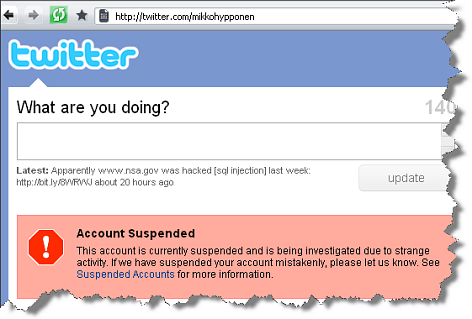Twitter suspends security researcher's account as a threat

Twitter erroneously suspended, and subsequently restored, a prominent researcher's account two months after he tweeted a security warning intended to inform his audience about an imminent threat.
Aside from poor security handling, this situation offers a case study example of immature customer service and suggests problems with the organization's corporate culture.
Mikko H. Hyppönen, Chief Research Officer at well-known computer security and anti-virus firm F-Secure, discovered that Twitter unexpectedly banned his account without warning. Here's a screen capture (that I edited for clarity) from Mikko's blog:

When Mikko complained, Twitter restored his account with this minimal explanation:
I've unsuspended your acct. You were suspended for using the malware URL rnyspeceDOTcom in DMs. Be careful! We scan evrythng for malware.
Apparently, this tweet got Mikko intro trouble:
I asked Mikko to share his thoughts on what happened:
Obviously, I was quite surprised about the whole incident. As I've worked with Twitter previously regarding Twitter worms and such, I really didn't expect this. In addition, I wasn't expecting them to ban me because of a tweet that was actually warning users to stay away from a phishing site. I think their process leaves a lot to be desired.
Twitter did not immediately respond to my request for comment.
THE PROJECT FAILURES ANALYSIS
There are several problematic aspects regarding Twitter's handling of this matter:
- Twitter waited two months to suspend Mikko's account after he sent the "illegal" tweet. A two-month delay responding to perceived security threats does little to protect users.
- This case has extreme irony because Mikko's tweet attempted to warn followers away from a major security threat. In addition, his tweet included spaces in the middle of the address, making it non-clickable for readers.
- For the coup de grâce, the company's explanation is rude, blames the user, and does not even apologize. In addition, Twitter did not restore any of Mikko's followers or the people he followed.
One might expect a small, poorly funded startup to exhibit these problems, but that's not Twitter's situation. According to Bloomberg, the company is valued at $1 billion, having raised $150 million.
Cute logos and web page illustrations are no substitute for genuine customer service values. If the company doesn't improve customer service attitudes, its reputation may one day descend to the level of cable and telephone companies: hated utility services that we tolerate until a replacement comes along.